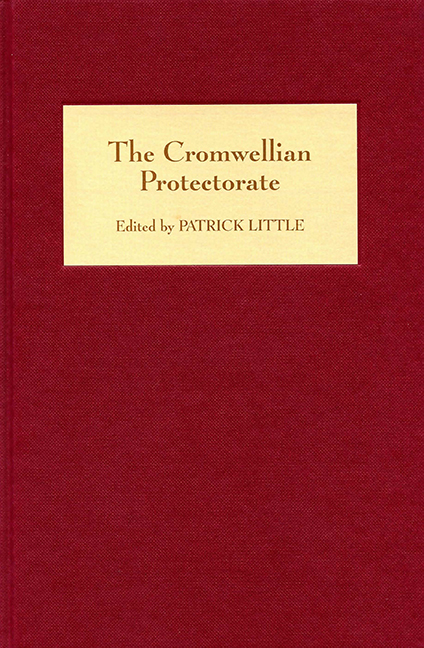Book contents
- Frontmatter
- Contents
- List of Illustrations
- Preface
- Notes on Contributors
- Abbreviations
- 1 Introduction
- 2 Oliver Cromwell and the Protectorate Parliaments
- 3 The Protector Humbled: Richard Cromwell and the Constitution
- 4 Cromwellian Style: The Architectural Trappings of the Protectorate Regime
- 5 Oliver Cromwell and the Council
- 6 ‘To Create a Little World out of Chaos’: The Protectoral Ordinances of 1653–1654 Reconsidered
- 7 The Irish and Scottish Councils and the Dislocation of the Protectoral Union
- 8 ‘This Murmuring and Unthankful Peevish Land’: Wales and the Protectorate
- 9 Cromwellian Towns in the Severn Basin: A Contribution to Cis-Atlantic History?
- 10 Policing the Cromwellian Church: The Activities of the County Ejection Committees, 1654–1659
- Index
4 - Cromwellian Style: The Architectural Trappings of the Protectorate Regime
Published online by Cambridge University Press: 24 October 2017
- Frontmatter
- Contents
- List of Illustrations
- Preface
- Notes on Contributors
- Abbreviations
- 1 Introduction
- 2 Oliver Cromwell and the Protectorate Parliaments
- 3 The Protector Humbled: Richard Cromwell and the Constitution
- 4 Cromwellian Style: The Architectural Trappings of the Protectorate Regime
- 5 Oliver Cromwell and the Council
- 6 ‘To Create a Little World out of Chaos’: The Protectoral Ordinances of 1653–1654 Reconsidered
- 7 The Irish and Scottish Councils and the Dislocation of the Protectoral Union
- 8 ‘This Murmuring and Unthankful Peevish Land’: Wales and the Protectorate
- 9 Cromwellian Towns in the Severn Basin: A Contribution to Cis-Atlantic History?
- 10 Policing the Cromwellian Church: The Activities of the County Ejection Committees, 1654–1659
- Index
Summary
Among the more striking images of the Cromwellian protectorate are the descriptions of the formal audiences granted to foreign ambassadors. Their normal venue was the Banqueting House of Whitehall Palace, a building indelibly associated with the execution of Charles I, and yet one whose architectural style and lavish fittings remained redolent of the Stuart regime in all its splendour. Here, beneath Rubens's great ceiling panels celebrating the reign of James I, Oliver Cromwell accorded visiting dignitaries an elaborate, ceremonial welcome that similarly revived memories of the English monarchy. Cromwell's semi-regal image as lord protector attracted criticism at the time, and still exercises scholars today. Roy Sherwood, in his study of Cromwell's court, has argued that the pomp and show was no more than was expected of a head of state, and that its scale and costs were modest compared with those of the Caroline establishment. Laura Lunger Knoppers has gone further, asserting that ‘Cromwell's own self-representation was never monarchical’, and that indeed he ‘was remarkably passive in shaping a protectoral image’. Given that the sober modesty of Cromwell's everyday dress and conduct is well attested, it might reasonably be concluded that his personal preferences were sharply at odds with the opulent surroundings of his official residences. In an age when it was taken for granted that buildings conveyed messages about the power and status of their owners, such disparity would be remarkable, a measure even of the inner tensions of the regime. However, the architectural context has never been fully explored, and the surviving evidence from this source paints a rather different picture, in which the lord protector not only relished his new environment, but actively sought to enhance it.
Cromwell's role as an architectural patron has never attracted much comment. While modern research has debunked the myth that he regularly ordered the wholesale destruction of property during the civil war, his rehabilitation has not extended to a reappraisal of his more constructive activities. Sir Howard Colvin's monumental History of the King's Works devotes just four pages to the surveyor-general's office during the years 1653–9, and broadly concludes that nothing of real significance happened. In one respect that is a fair assessment. Of all the capital projects pursued by the protectorate regime, the only major new structures were four imposing but short-lived citadels erected in Scotland, beyond the remit of the King's Works.
- Type
- Chapter
- Information
- The Cromwellian Protectorate , pp. 53 - 81Publisher: Boydell & BrewerPrint publication year: 2007



